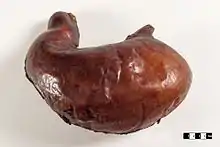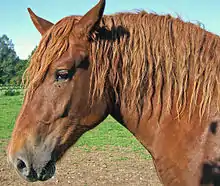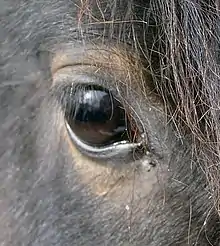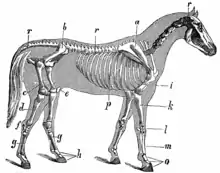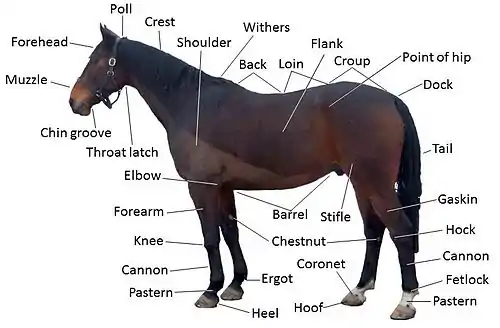Portal:Horses
The Horses Portal.jpg.webp)
The horse (Equus ferus caballus) is a domesticated, one-toed, hoofed mammal. It belongs to the taxonomic family Equidae and is one of two extant subspecies of Equus ferus. The horse has evolved over the past 45 to 55 million years from a small multi-toed creature, close to Eohippus, into the large, single-toed animal of today. Humans began domesticating horses around 4000 BCE, and their domestication is believed to have been widespread by 3000 BCE. Horses in the subspecies caballus are domesticated, although some domesticated populations live in the wild as feral horses. These feral populations are not true wild horses, which are horses that never have been domesticated. There is an extensive, specialized vocabulary used to describe equine-related concepts, covering everything from anatomy to life stages, size, colors, markings, breeds, locomotion, and behavior. Horses are adapted to run, allowing them to quickly escape predators, and possess an excellent sense of balance and a strong fight-or-flight response. Related to this need to flee from predators in the wild is an unusual trait: horses are able to sleep both standing up and lying down, with younger horses tending to sleep significantly more than adults. Female horses, called mares, carry their young for approximately 11 months and a young horse, called a foal, can stand and run shortly following birth. Most domesticated horses begin training under a saddle or in a harness between the ages of two and four. They reach full adult development by age five, and have an average lifespan of between 25 and 30 years. Horse breeds are loosely divided into three categories based on general temperament: spirited "hot bloods" with speed and endurance; "cold bloods", such as draft horses and some ponies, suitable for slow, heavy work; and "warmbloods", developed from crosses between hot bloods and cold bloods, often focusing on creating breeds for specific riding purposes, particularly in Europe. There are more than 300 breeds of horse in the world today, developed for many different uses. (Full article...)
|
| Article alerts for WikiProject Equine |
|
Did you know
Articles for deletion
Redirects for discussion
Requested moves
Articles to be merged
Articles for creation |
| Updated daily by bot |
More did you know?

- ... that the British racehorse Simonsig (pictured) won his début in steeplechase by 49 lengths, then followed that up with a 35-length victory a few days later?
- ... that, because of their unique genetic makeup, the feral horses on the Pryor Mountains Wild Horse Range "may be the most significant wild-horse herd remaining in the U.S."?
- ... that until 1959, the Finnhorse was the only horse breed allowed to be raced in Finland?
Related portals
 Selected breed -
Selected breed - 
Kaimanawa horses are a population of feral horses in New Zealand that are descended from domestic horses released in the 19th and 20th centuries. They are known for their hardiness and quiet temperament. The New Zealand government strictly controls the population to protect the habitat in which they live, which includes several endangered species of plants. The varying heritage gives the breed a wide range of heights, body patterns and colours. They are usually well-muscled, sure-footed and tough.
Horses were first reported in the Kaimanawa Range in 1876, although the first horses had been brought to New Zealand in 1814. The herds grew as horses escaped or were released from sheep stations and cavalry bases. Some of the horses were recaptured by the locals to be riding horses, as well as for their meat, hair, and hides. The number of horses declined as large-scale farms and forestry operations were built on the ranges, and there was only around 174 horses by 1979. The New Zealand government started protecting the Kaimanawa horses in 1981, and there were 1,576 horses by 1994. Roundups have been carried out annually since 1993 to manage the size of the herd, removing around 2,800 horses altogether. All suitable horses are available for rehoming after the roundups. The Kaimanawa horse population is listed as a herd of special genetic value by the United Nations' Food and Agriculture Organization, and several studies have been conducted on the herd dynamics and habits of the breed. (Full article...)Did you know (auto-generated)
- ... that when Jalal al-Din realised that he would be defeated at the Battle of the Indus, he rode his horse off a 30-foot (10 m) cliff into the Indus River?
- ... that Rod Bonella, who won a Commonwealth Games marathon medal, was also a horse trainer?
- ... that a 19th-century horse stable in New York City later housed a luxury pet sitter for cats and dogs?
- ... that the Morris County Park Commission in New Jersey oversees over 20,000 acres (8,100 ha) of land, including a marina, an ice skating arena, a horse stable, a historical farm, and a gristmill?
- ... that Martin Pipe's training methods for steeplechasers were so effective, he was investigated twice for cheating?
- ... that at the age of 12, the Lakota spiritual leader Arvol Looking Horse became the youngest ever Keeper of the Sacred White Buffalo Calf Pipe and Bundle?
General images
Topics
Horse • Pony • Asinus • Equus (genus) • Equidae • Zebra • Glossary of equestrian terms • List of horse breeds • Evolution of the horse • Domestication of the horse • Horse care • Stable • Horse training • Equestrianism • Horse tack • Saddle • Equine nutrition • Equine anatomy • Equine conformation • Equine coat color • Equine coat color genetics • Horse markings • Equine vision • Horse hoof • Horseshoe • Horse gait • Horse behavior • Horse breeding • Breed registry • Equine infectious anemia • Horse colic • Lameness • Laminitis • Horse slaughter • Horses in warfare • Arabian horse • Thoroughbred
Subcategories
- Select [►] to view subcategories
New articles
Rules | Match log | Results page (for watching) | Last updated: 2023-10-26 20:28 (UTC)
Note: The list display can now be customized by each user. See List display personalization for details.
- Lee Newman (jockey) (edit | talk | history | links | watch | logs | tools) by Peaky76 (talk · contribs · new pages (23)) started on 2023-10-26, score: 40
- Marco Ghiani (edit | talk | history | links | watch | logs | tools) by Peaky76 (talk · contribs · new pages (23)) started on 2023-10-26, score: 60
- 1988 NSL Cup final (edit | talk | history | links | watch | logs | tools) by FastCube (talk · contribs · new pages (10)) started on 2023-10-26, score: 30
- New Altai (edit | talk | history | links | watch | logs | tools) by Seakingk (talk · contribs · new pages (28)) started on 2023-10-25, score: 140
- British Warmblood (edit | talk | history | links | watch | logs | tools) by Seakingk (talk · contribs · new pages (28)) started on 2023-10-25, score: 170
- Chris Catlin (edit | talk | history | links | watch | logs | tools) by Peaky76 (talk · contribs · new pages (23)) started on 2023-10-25, score: 40
- Equestrian at the 2023 Pan American Games – Team dressage (edit | talk | history | links | watch | logs | tools) by JuliánLeiva66 (talk · contribs · new pages (35)) started on 2023-10-25, score: 50
- Arabo-friesian (edit | talk | history | links | watch | logs | tools) by Seakingk (talk · contribs · new pages (28)) started on 2023-10-24, score: 150
- Benoit de la Sayette (edit | talk | history | links | watch | logs | tools) by Peaky76 (talk · contribs · new pages (23)) started on 2023-10-24, score: 40
- Greg Fairley (edit | talk | history | links | watch | logs | tools) by Peaky76 (talk · contribs · new pages (23)) started on 2023-10-24, score: 40
- Amy Ryan (jockey) (edit | talk | history | links | watch | logs | tools) by Peaky76 (talk · contribs · new pages (23)) started on 2023-10-24, score: 40
- John Bisdee (RAF officer) (edit | talk | history | links | watch | logs | tools) by Zawed (talk · contribs · new pages (3)) started on 2023-10-24, score: 30
- List of 20th Century Fox films (1935–1999) (edit | talk | history | links | watch | logs | tools) by 2601:283:4600:7050:55A4:290:EBA5:F277 (talk · contribs · new pages (1)) started on 2023-10-24, score: 30
- List of 1970s films based on actual events (edit | talk | history | links | watch | logs | tools) by PrimeHunter (talk · contribs · new pages (5)) started on 2023-10-24, score: 40
- Kitty's Light (edit | talk | history | links | watch | logs | tools) by Southdevonian (talk · contribs · new pages (1)) started on 2023-10-23, score: 50
- Jason Hart (jockey) (edit | talk | history | links | watch | logs | tools) by Peaky76 (talk · contribs · new pages (23)) started on 2023-10-23, score: 60
- Robert Havlin (edit | talk | history | links | watch | logs | tools) by Peaky76 (talk · contribs · new pages (23)) started on 2023-10-23, score: 50
- George Bellhouse (edit | talk | history | links | watch | logs | tools) by Peaky76 (talk · contribs · new pages (23)) started on 2023-10-23, score: 40
- Henri Jelliss (edit | talk | history | links | watch | logs | tools) by Peaky76 (talk · contribs · new pages (23)) started on 2023-10-23, score: 30
- Mostahdaf (edit | talk | history | links | watch | logs | tools) by Almargarea (talk · contribs · new pages (5)) started on 2023-10-23, score: 40
- Liberty Island (horse) (edit | talk | history | links | watch | logs | tools) by Jnglmpera (talk · contribs · new pages (4)) started on 2023-10-23, score: 60
- 1996 Melbourne Cup (edit | talk | history | links | watch | logs | tools) by ToddyOC (talk · contribs · new pages (3)) started on 2023-10-23, score: 40
- Brownie Carslake (edit | talk | history | links | watch | logs | tools) by Peaky76 (talk · contribs · new pages (23)) started on 2023-10-22, score: 40
- Walter Griggs (edit | talk | history | links | watch | logs | tools) by Peaky76 (talk · contribs · new pages (23)) started on 2023-10-22, score: 70
- British Champions Fillies' and Mares' Stakes (edit | talk | history | links | watch | logs | tools) by JockeyColours (talk · contribs · new pages (1)) started on 2023-10-22, score: 80
- Frankie Durr (edit | talk | history | links | watch | logs | tools) by Peaky76 (talk · contribs · new pages (23)) started on 2023-10-22, score: 30
- List of May Bukas Pa episodes and chapters (edit | talk | history | links | watch | logs | tools) by Ervin111899 (talk · contribs · new pages (3)) started on 2023-10-22, score: 30
- Frank Hardy (jockey) (edit | talk | history | links | watch | logs | tools) by Peaky76 (talk · contribs · new pages (23)) started on 2023-10-22, score: 40
- Equestrian at the 2022 Asian Games – Team eventing (edit | talk | history | links | watch | logs | tools) by Yikesaiting (talk · contribs · new pages (49)) started on 2023-10-22, score: 60
- Equestrian at the 2022 Asian Games – Team jumping (edit | talk | history | links | watch | logs | tools) by Yikesaiting (talk · contribs · new pages (49)) started on 2023-10-22, score: 40
- Tony Murray (jockey) (edit | talk | history | links | watch | logs | tools) by Peaky76 (talk · contribs · new pages (23)) started on 2023-10-22, score: 60
- Paul Cook (jockey) (edit | talk | history | links | watch | logs | tools) by Peaky76 (talk · contribs · new pages (23)) started on 2023-10-21, score: 50
- Persik (endurance horse) (edit | talk | history | links | watch | logs | tools) by Shellypls (talk · contribs · new pages (8)) started on 2023-10-21, score: 150
- William Edward Armitage (edit | talk | history | links | watch | logs | tools) by Spinster300 (talk · contribs · new pages (33)) started on 2023-10-21, score: 40
- Marco Polo (1982 TV series) (edit | talk | history | links | watch | logs | tools) by Robertsky (talk · contribs · new pages (97)) started on 2023-10-21, score: 30
- Equestrian at the 2022 Asian Games – Individual jumping (edit | talk | history | links | watch | logs | tools) by Yikesaiting (talk · contribs · new pages (49)) started on 2023-10-21, score: 50
- Phaéton (trotter horse) (edit | talk | history | links | watch | logs | tools) by Shellypls (talk · contribs · new pages (8)) started on 2023-10-21, score: 150
- Paul Mulrennan (edit | talk | history | links | watch | logs | tools) by Peaky76 (talk · contribs · new pages (23)) started on 2023-10-20, score: 80
- Wipeout (season 1) (edit | talk | history | links | watch | logs | tools) by 98.97.176.47 (talk · contribs · new pages (1)) started on 2023-10-20, score: 40
- List of films based on actual events (before 1980) (edit | talk | history | links | watch | logs | tools) by Eyesnore (talk · contribs · new pages (2)) started on 2023-10-20, score: 100
- List of 1980s films based on actual events (edit | talk | history | links | watch | logs | tools) by Eyesnore (talk · contribs · new pages (2)) started on 2023-10-20, score: 30
- List of Acts of the Parliament of the United Kingdom from 1951 (edit | talk | history | links | watch | logs | tools) by Mauls (talk · contribs · new pages (171)) started on 2023-10-19, score: 30
- Narquois (racehorse) (edit | talk | history | links | watch | logs | tools) by Shellypls (talk · contribs · new pages (8)) started on 2023-10-18, score: 150
- Yuga Kawada (edit | talk | history | links | watch | logs | tools) by Jnglmpera (talk · contribs · new pages (4)) started on 2023-10-17, score: 70
- Horse symbolism (edit | talk | history | links | watch | logs | tools) by Carlos Eduardo Wester Pérez (talk · contribs · new pages (7)) started on 2023-10-16, score: 210
- Tournament of Kings (edit | talk | history | links | watch | logs | tools) by Cunard (talk · contribs · new pages (2)) started on 2023-10-16, score: 80
- List of Princess Tina stories (edit | talk | history | links | watch | logs | tools) by BoomboxTestarossa (talk · contribs · new pages (2)) started on 2023-10-14, score: 40
- Blackpool Racecourse (edit | talk | history | links | watch | logs | tools) by Peaky76 (talk · contribs · new pages (23)) started on 2023-10-14, score: 30
- Idiomatic (horse) (edit | talk | history | links | watch | logs | tools) by Brudder Andrusha (talk · contribs · new pages (1)) started on 2023-10-14, score: 70
- Niger (trotter horse) (edit | talk | history | links | watch | logs | tools) by Shellypls (talk · contribs · new pages (8)) started on 2023-10-13, score: 170
- Kenichi Ikezoe (edit | talk | history | links | watch | logs | tools) by Jnglmpera (talk · contribs · new pages (4)) started on 2023-10-12, score: 50
- Kalakla (edit | talk | history | links | watch | logs | tools) by FuzzyMagma (talk · contribs · new pages (58)) started on 2023-10-12, score: 30
- Kara Jorga (edit | talk | history | links | watch | logs | tools) by Utopes (talk · contribs · new pages (55)) started on 2023-10-12, score: 60
- Concours Hippique International Officiel (edit | talk | history | links | watch | logs | tools) by Grorp (talk · contribs · new pages (3)) started on 2023-10-09, score: 110
WikiProjects
- Equine Wikiproject
- Horse Breed Taskforce
- Horse Training Taskforce
- Horse racing Wikiproject
- Veterinary medicine Wikiproject
- Agriculture Wikiproject
Associated Wikimedia
The following Wikimedia Foundation sister projects provide more on this subject:
-
 Commons
Commons
Free media repository -
 Wikibooks
Wikibooks
Free textbooks and manuals -
 Wikidata
Wikidata
Free knowledge base -
 Wikinews
Wikinews
Free-content news -
 Wikiquote
Wikiquote
Collection of quotations -
 Wikisource
Wikisource
Free-content library -
 Wikispecies
Wikispecies
Directory of species -
 Wikiversity
Wikiversity
Free learning tools -
 Wiktionary
Wiktionary
Dictionary and thesaurus
-
 List of all portalsList of all portals
List of all portalsList of all portals -
 The arts portal
The arts portal -
 Biography portal
Biography portal -
 Current events portal
Current events portal -
 Geography portal
Geography portal -
 History portal
History portal -
 Mathematics portal
Mathematics portal -
 Science portal
Science portal -
 Society portal
Society portal -
 Technology portal
Technology portal -
 Random portalRandom portal
Random portalRandom portal -
 WikiProject PortalsWikiProject Portals
WikiProject PortalsWikiProject Portals
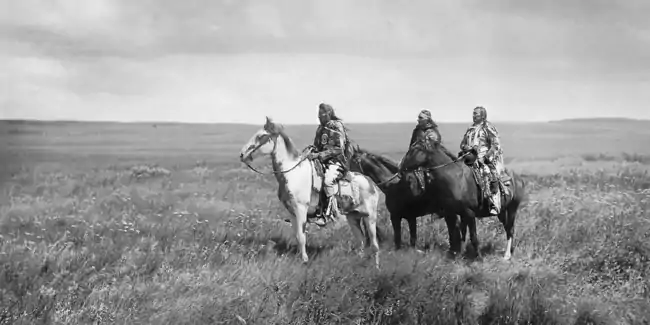




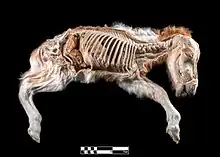
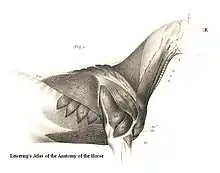






%252C_stored_at_the_Lyndon_B._Johnson_Presidential_Library.jpg.webp)

